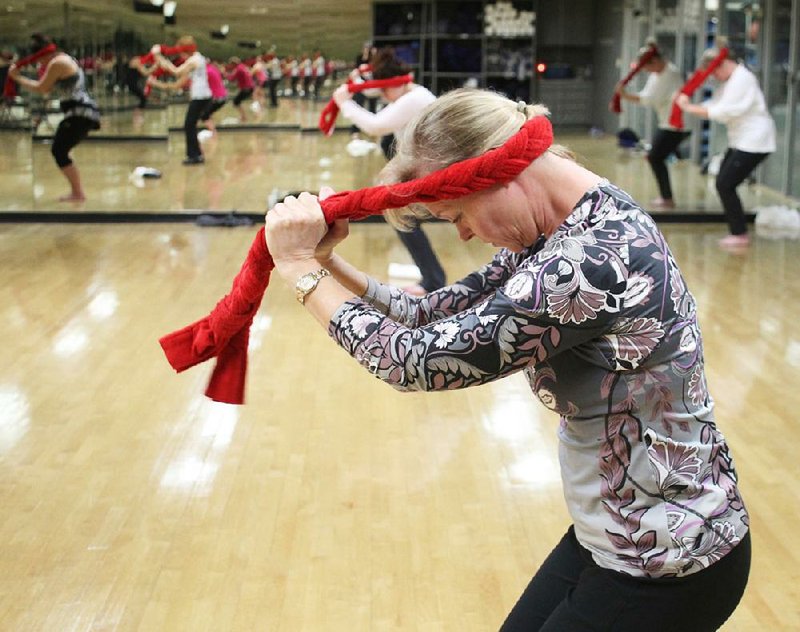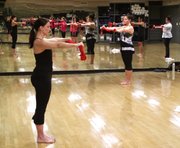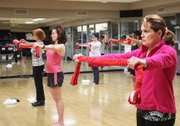LITTLE ROCK — Sixteen barefoot women holding red towels over their heads look like hundreds in a room with mirrors for walls.
This noontime exercise class at Little Rock Athletic Club creates quite the colorful regress of images as mirrors on three walls of the workout classroom reflect on each other. Dial down the overhead spotlights so the wooden floor gleams dimly, and there’s almost a moving experience to consider in those mirrors.
So imagine yourself where I was on two recent Thursdays, in a mirrored corner of the group-exercise room watching that series of bodies (reflections smaller, smaller, smaller) vanish into the depths of geometry. Imagine their myriad faces as a repeated motif framed by black shelving: brilliant pink or black-and-white workout attire and then little slashes of red from the towels they hold.
They have borrowed the towels - four-foot lengths of braided terrycloth - from instructor Julia Taylor, a calm woman in a black leotard who stands front and center near a black stripe of shelving that holds the DVD player and sound controls for the room.
New and only meeting once a week, Fletcher Fusion doesn’t always draw 16. Taylor says the first class had three students, another just 10. But dim the lights anyway. Put yourself in the room.
Is there music pulsing from the sound system? No. Instead, add to the scene an almost tidal shusshing sound as many of these women attempt to inhale and exhale in tandem with precise motions.
“The breath is a real fundamental piece, just like it is” in other Pilates classes, Taylor says. “It’s inhale through the nose and it’s exhale through the mouth; that’s just like the usual Pilates breath, but the difference in the Ron Fletcher method - he calls it ‘percussive breath’ - is that your mouth is a little bit narrow.
“You’re exhaling through a narrower mouth so your breath makes that shusshing sound.
“But I don’t want you to worry too much about the sound, because when you started doing that, then you’d get a little bit into your neck, you’d get a little shallow, shh! shh! shh!, and you’d be forcing it out. You want your breath to be flowing up from the diaphragm.”
To help the women feel the percussion, she has them stand with hands holding each side of their waists, fingers placed so they rise and fall with the rib cage. Together, they inhale and exhale - shhhhuuuussh.
PERSONAL CHARM
Websites don’t know everything, of course, but Taylor is the only Arkansan listed on the website of Fletcher Pilates as a credentialed “Fletcher Fusion provider.”
“I didn’t do my whole training with Fletcher, I did it as continuing education and took their five-day intensive in Chicago to be able to teach this,” she says. She holds mat and equipment certifications from Centerworks Pilates, which requires more than 650 hours of training. She’s also a member of the Pilates Method Alliance.
Fletcher Pilates is not as familiar here as other styles of the mind-body exercise inspired by the late Joseph and Clara Pilates’ methods. So who was Fletcher and what did he fuse?
The late Ron Fletcher was one of a handful of Pilates entrepreneurs known as “the elders,” because they learned the method directly from the couple in the 1930s and ’40s in New York. According to Fletcher’s obituary in the Los Angeles Times, he was the elder most responsible for giving the mind-body method its celebrity cachet.
A Missouri boy with no formal education in dance, Fletcher charmed his way into the prestigious Martha Graham Dance Company in New York. Like others in Graham’s company, he turned to Joseph Pilates for help with injuries, in his case, a sore knee. (A nurse, Pilates had developed a method of physical rehabilitation for bedridden invalids, but since there were dancers in the building where he and Clara rented space, he specialized in rehab for dancers.)
In 1946, Fletcher left Graham to work on a Broadway musical starring Mary Martin, The Lute Song, and its success launched him as a solo dancer and choreographer. He choreographed for theater, TV, films and nightclubs. According to Jim Davidson’s blog “Classic TV Info,” on NBC’s All Star Revue, Fletcher’s featured dancer was Tallulah Bankhead.
He staged Ice Capades shows for 13 years until, the obituary relates, he missed a big one while on a bender and was fired for drinking.
He joined Alcoholics Anonymous and returned to Pilates, training with Clara after Joseph died in 1967.
Eventually Fletcher moved to Los Angeles, where with Clara Pilates’ approval, in1972 he opened the first Pilates studio on the West Coast, above an exclusive salon on Rodeo Drive.
He refused to advertise; word of mouth attracted a Hollywood Who’s Who, beginning with the novelist Judith Krantz. Krantz told the Times he was “ultra-charming,” winning her heart when they first met by introducing himself as a gay recovering alcoholic of mixed parentage. His classes were challenging but hilarious. Clients included Candice Bergen, Ali MacGraw, Dyan Cannon, Katharine Ross, Barbra Streisand, Raquel Welch and Cher.
As Pilates caught on after a judicial ruling in 2000 made it impossible for the New York studio Pilates Inc. to trademark the method, Fletcher closed shop in Beverly Hills and retired with his partner, John Battles, to Texas. In December 2011, 90 years old, he died peacefully at home in Stonewall, Texas.
FLETCHER WORK
The Fletcher method fuses Pilates mat work with elements of ballet - barre training and standing motions from dance - all of which should flow together in sequences he called “pieces,” intensified by his percussive breathing.
Taylor’s hour-long classes begin by encouraging self-awareness from the ground up: It’s a piece for the feet, with toes lifting and lowering and heel raises.
Each class is a different combination of pieces, but the work includes feet, legs, hips, back, upper body and even wrists. Some standing and some seated pieces use braided towels for resistance, but not all do; and there are lunges and plies with sweeping arm motions.
There are also seated and supine pieces in which students must concentrate to move hips, legs and feet one at a time through small-range of-motion sequences that progress to wider motions of the legs and hip openers.
The pace is stately. The movements are slow enough that they look like stretches (some are stretches) and repeated often enough that people begin to “get it,” and so all of that toe pointing and controlled gesturing of the hands starts to look like grace.
No one is sweating, grunting or gasping.
The point?
“It’s a movement experience,” Taylor says.
BOLTS AND MAGNETS
Taylor’s classes draw from the general audience at the club, so she can’t assume everyone remembers what she taught the week before. So she begins each session with a quick overview of breathing and advises students to imagine bolts and magnets on their bodies:
“Think about magnets in the legs,” she says. “Your magnet points depend on the shape of your leg, either your ankle or for me it’s my calf, because to make my ankles touch I’d have to roll my feet in. So one magnet for calf or ankle, then one just above the knee and then one right below the groin. Those three magnets are going to be drawing together when you’re in the standing position, and then as you move in and out of positions, you’ll want to re-engage your magnets.”
Next she asks students to center their weight over their feet, rolling onto their toes, heels and then from side to side to feel how foot placement affects the balance of their weight.
The four bolts are a mental image intended to help them visualize hip posture. Think of one bolt on the front above the pubic bone, another on the back above the sacrum, and then one bolt on each side of the hips where you feel their bony prominence.
“Find your magnets, find your bolts,” she says.
BREATH AND BREADTH
After class, students compare impressions.
“It does feel good,” says Toni Meghreblian. “You think it looks easy, but it’s hard because you have to think the whole time and make sure everything’s where it’s supposed to be. … You can’t just go through the motions.”
The fact that she studied ballet years ago and has done some Pilates, too, helped her focus on the breath. “That’s another thing you have to think about. You have to remind yourself to breathe while your legs are poking in the right direction.”
Whitney Montague did not take ballet in childhood, but “I’ve done Pilates, not that much, but Pilates and yoga. I found it much more peaceful - no, not ‘peaceful,’ more energizing, in a way. It put me more on track.
“My challenge with Pilates and yoga is I’m a very active person and I have a difficult time finding the rhythm sometimes in these classes,” Montague says. “In this class, it was much easier to click into the rhythm.” She credits the breath: “It helped. It was more as if I was incorporating the movement into the breath rather than the breath into the movement. I really enjoyed it.”
Stephanie Golleher is also a “very active,” athletic woman who prefers intense exercise. She has no dance background, but she has done some yoga and Pilates. She prefers Hot Yoga - “I’m right there with that. I kind of drop out at the relaxing part.”
She was not thrilled by Fletcher Fusion. The reaching and stretching didn’t feel challenging, she chafed against the restricted breath, and she missed feeling her heart race.
“What is the point of the workout?” she asks.
“It is about the experience,” Taylor says. “It’s fun, basically. If it’s not fun to you, it’s not fun to you. It’s not for everybody. Not everybody loves it and I understand that. … It’s actually not so good for anyone with knee problems or back problems.
“But the main thing I would say is that it’s enjoyable and it brings awareness to your body, grace, strength and flexibility. It leaves me feeling energized.”
ActiveStyle, Pages 27 on 02/18/2013



